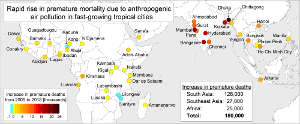Understanding longevity: From gene sequences to social inequity
03 April 2025
Published online 20 April 2022
Fast-growing cities in the Middle East show distinct increases in major air pollutants with profound implications for human health.

Vohra et al. (2022)
Enlarge image
Many tropical cities are projected to reach populations of between 40 and 80 million by the year 2100. With this rapid urbanisation comes a rise in air pollutant emissions from intensive human activity, with significant ramifications for health and mortality.
“Cities in the tropics are the next frontier in air pollution,” says Karn Vohra at University College London, UK, who was involved in the study. “These cities are experiencing population growth at an unprecedented pace, yet have limited routine air pollution monitoring on the ground. Many tropical countries are yet to implement policies and set up infrastructure to mitigate air pollution.”
Vohra and colleagues analysed satellite data collected from 2005 to 2018 to quantify annual increases in key pollutants – including nitrogen dioxide, ammonia, fine particles (PM2.5), and reactive volatile organic compounds – in the 46 cities selected.
“Many of these pollutants are very hazardous to health. PM2.5 penetrates deep into the lungs and affects almost every organ in the body,” says Vohra. Inhaling such particles ultimately shortens people’s lives.
“When compared with pollution levels in major cities in Asia, the figures for Riyadh, Sana’a and Khartoum are low,” says Vohra. “However, the rates at which air quality is degrading are steeper than those in other cities in Africa and Asia.”
It is challenging to observe aerosols over desert regions using space-based instruments, so trends in PM2.5 are not reported in the study for Riyadh and Khartoum. This meant the team could not compute the premature mortality rates for these cities. However, premature deaths in Sana’a from long-term exposure to PM2.5 more than doubled from 1,600 in 2005, to 3,300 in 2018.
Vohra notes that these future megacities are facing this challenge at a time when access to emission control technologies and renewable energy is getting cheaper and easier to implement. “We hope that our study will incentivise policymakers to put measures in place so that development can occur without severely impacting public health.”
doi:10.1038/nmiddleeast.2022.21
Vohra, K. et al. Rapid rise in premature mortality due to anthropogenic air pollution in fast-growing tropical cities from 2005 to 2018. Sci Adv 8, eabm4435 (2022).
Stay connected: